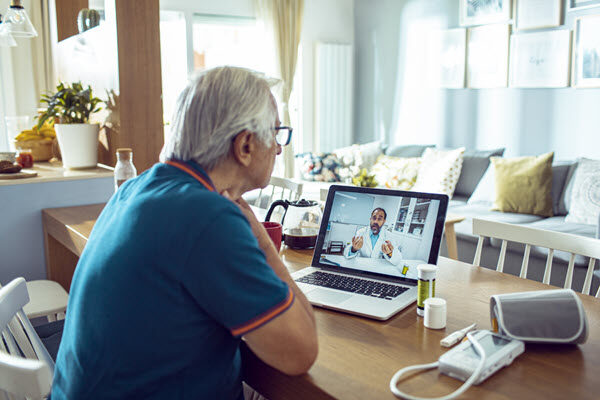The past two years have proven that telehealth and virtual care are here to stay and will gain strength going forward for patients, providers, and payers. With the ability to provide healthcare to a vast array of patients, the next question is “now what?” How can we improve and customize a better experience for patients, providers, and payers?
Although telehealth has been available for many years, it was not utilized to its full potential as physician reimbursements were relatively small compared to in-person visits. During the start of the pandemic, CMS and congress approved a waiver which allowed clinicians to bill at or near the same rate as in-person, https://www.cms.gov/files/document/summary-covid-19-emergency-declaration-waivers.pdf. As of March 15, 2022, CMS and Congress have approved an extension of Medicare telehealth waivers.
To illustrate how telehealth impacted healthcare during 2020, CMS (Centers for Medicare & Medicaid Services) reported a 63-fold increase in Medicare telehealth utilization during the COVID-19 pandemic. Medicare visits conducted through telehealth in 2020 went from 840,000 to 52.7 million, with behavior health being the most prevalent, New HHS Study Shows 63-Fold Increase in Medicare Telehealth Utilization During the Pandemic | CMS.
As an RN, I worked as a Case Manager and my role was to secure a safe return home for my patients and remind the patient to only come back to the ER if necessary. Unfortunately, this did not help our 30-day readmissions issues as many patients were back within 4 days of being discharged. This was prior to telehealth’s explosion into the healthcare playing field. With the prevalence of telehealth, Zoom calls are now the common role with care, providing a better experience for the patient and the clinician. During a virtual conversation, the clinician can understand and visualize (if needed) the patients’ issues and adjust medications or treatment based on these findings. Not having to make another trip to the ER reduces the fear and anxiety the patient may be experiencing and can relax as help is just a phone call away. The entire scenario benefits the payer as there was not another visit to the ER and to the hospital related to the 30-day readmissions penalty.
By educating our patients on the use-cases telehealth can provide, we can impact healthcare on many different levels. First thought is with providing a safe experience for our patients. A story that resonates for me regarding the need for telehealth occurred during the 2009 H1N1 Pandemic. I was working as Triage RN in the Emergency Department, and we had over 150 people waiting to be seen that could have had the flu or H1N1. My partner and I looked up to see a mother with her newborn baby coming into our doors. The new mother was worried about a skin rash on her 10-day old baby. We knew we had to get them out of our waiting room as quickly as possible due to nearly 200 people with H1N1, Flu, and RSV symptoms waiting to be seen. This would have been a very safe and easy video chat with her pediatrician as this was simply a newborn rash and would go away within a couple of days. The baby did not even need a prescription!
Another level is to address the different uses for telehealth beyond the top uses which are dermatology and behavior health. What about chronic disease management? By utilizing analytics along with telehealth, hospitals and payers could track patients with chronic conditions and create a better care strategy. NIH states 75% of all healthcare expenditures account for chronic disease managed by in-person office visits, https://www.ncbi.nlm.nih.gov/books/NBK207141/. NIH reports the use of telehealth management helped reduce hospitalizations, readmissions, length of stay and cost. Not only is this financially beneficial, but it also protects the patient from medical errors associated with being hospitalized and from Hospital Acquired Infections (HAIs) which can be catastrophic physically and mentally to the patient and financially to the hospital. Keeping our patients safe is always a top concern.
Moving forward with technology and virtual care, we need to improve analytics to pinpoint which patient demographic, disease process, or other circumstances can best be treated virtually. Also, looking at every hospital providing an RPM service and identifying how best to treat patients as not every “visit” requires an in-person consultation.
Because of the progression and acceptance of telehealth, we have witnessed a dynamic increase impacting different areas ranging from rural community coverage to behavioral health issues addressed during a pandemic. The expectations and role of telehealth are now morphing into the next generation/level- Artificial Intelligence (AI) partnering with Telehealth and paving a new road for health care delivery. Many people for the first time are engaging in telehealth and experiencing the benefits provided as they do not need to wait to see their physician and receive the same care.
I remember trying to get a doctor’s appointment for a non-emergent issue and the first appointment was 4 weeks out! Because of this, I went to a “Doc-in-the-Box” and received treatment which is frustrating as this doctor doesn’t know anything about me and my medical history. This goes against continuation of care which is best practice in healthcare. Now my PCP offers telehealth and I have been able to use this a couple of times. By doing so, I feel good as this is my primary care doctor and she receives a full payment for the care provided.
With that being said, the user-experience needs to be an intuitive, easy to navigate, and provide analytics to provide the best optimization experience for all users.

